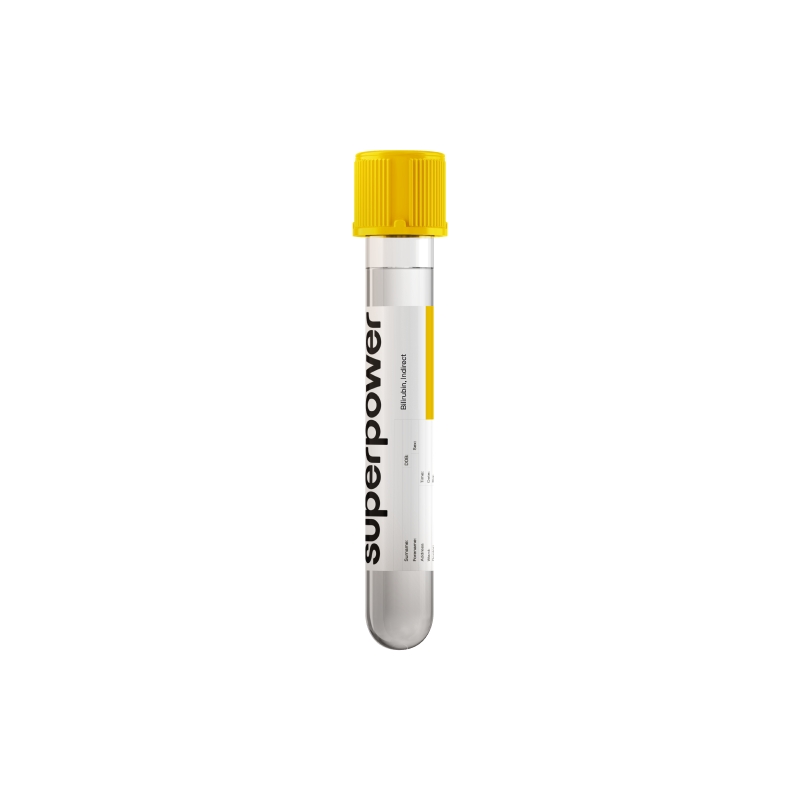Track your indirect bilirubin to understand liver processing, red blood cell turnover, and patterns of jaundice. Clear insights for training, recovery, and trend-based decisions.
Key Benefits
Measure the unconjugated (indirect) bilirubin your liver hasn’t processed yet.
- Spot red blood cell breakdown; rises with hemolysis before other signs appear.
- Explain intermittent yellowing from Gilbert syndrome; benign reduced conjugation activity.
- Clarify jaundice source when paired with direct bilirubin and liver enzymes.
- Guide next tests for hemolysis or ineffective erythropoiesis causing anemia.
- Explain yellow eyes without dark urine; indirect bilirubin isn’t excreted in urine.
- Track personal baseline; levels can rise with fasting, illness, or some drugs.
- Best interpreted with direct bilirubin, blood counts, hemolysis markers, and liver enzymes.
What is Bilirubin, Indirect?
Indirect bilirubin is the unconjugated form of bilirubin in the bloodstream, a yellow pigment generated when the body dismantles heme from aging red blood cells. Macrophages in the spleen, liver, and bone marrow convert heme to biliverdin (heme oxygenase) and then to bilirubin (biliverdin reductase). This unconjugated bilirubin is fat-soluble, not water-soluble, and circulates tightly bound to albumin as it travels to the liver for processing.
Indirect bilirubin is the in-transit waste product of heme catabolism, reflecting how much heme is being broken down and how effectively the liver takes it up for conjugation. In hepatocytes, the enzyme UGT1A1 attaches glucuronic acid (glucuronidation), producing water‑soluble, “direct” (conjugated) bilirubin that can be excreted in bile. At typical levels, bilirubin also functions as a circulating antioxidant and signaling molecule (redox modulator). Overall, the indirect fraction captures the upstream side of the bilirubin pathway—production, albumin transport, and hepatic uptake before conversion and excretion.
Why is Bilirubin, Indirect important?
Indirect (unconjugated) bilirubin is the lipid‑soluble breakdown product of heme from red blood cells. It travels bound to albumin to the liver, where it is conjugated for excretion. This marker shows how well your body balances red cell turnover, liver uptake, and conjugation—linking blood, liver, and brain health, and even antioxidant defenses.
Most labs flag a narrow normal range, and for most adults the healthiest pattern sits in the low‑to‑mid portion. Men tend to run slightly higher than women; pregnancy often nudges values lower; newborns naturally have higher levels for a few days after birth.
When values are on the low side, they usually reflect efficient conjugation, lower heme breakdown, or dilution (as in pregnancy). People typically feel fine. Because bilirubin is also an endogenous antioxidant, very low levels may correlate in studies with less antioxidant “buffer,” and have been associated with higher cardiometabolic risk, but symptoms are uncommon and causation is uncertain.
When values run high, think either extra production or slowed conjugation. Hemolysis increases production, leading to jaundice with anemia symptoms such as fatigue and shortness of breath; urine color often stays normal because unconjugated bilirubin is not excreted in urine. Reduced conjugation—classically Gilbert syndrome—causes intermittent, mild elevations during fasting, illness, or stress and is usually harmless. In newborns, very high indirect bilirubin can cross the blood–brain barrier and injure the nervous system.
Big picture, indirect bilirubin sits at the crossroads of red cell lifespan, hepatic UGT1A1 conjugation, and bile handling. It tracks oxidative stress capacity, flags hemolysis, and, when markedly elevated in infants, signals neurologic risk. Over time, sustained overproduction can contribute to pigment gallstones, while modest levels in adults often parallel overall metabolic and vascular health.
What Insights Will I Get?
Indirect (unconjugated) bilirubin is the heme‑breakdown pigment in blood before the liver makes it water‑soluble. It reflects red‑cell turnover and hepatic conjugation capacity, and also serves as an endogenous antioxidant tied to overall oxidative load.
Low values usually reflect low production or brisk hepatic clearance—less red‑cell breakdown or efficient conjugation (UGT1A1). They rarely indicate disease and are common in pregnancy due to hemodilution. System effects are minimal.
Being in range suggests steady heme recycling, intact hepatic transporters, and adequate glucuronidation, supporting stable metabolism and bile clearance. There is no consensus on an ideal spot; many healthy adults sit mid‑range, interpreted with total and direct bilirubin.
High values usually reflect increased production (hemolysis, ineffective erythropoiesis, resorbing bruises) or reduced hepatic uptake/conjugation (UGT1A1 variants like Gilbert syndrome, drug effects). Indirect predominates while direct stays normal. Adults may get intermittent jaundice with fasting; newborns are high physiologically, and extreme levels are neurotoxic.
Notes: Men average slightly higher; newborns highest. Fasting, illness, and assay differences shift results. Indirect bilirubin is calculated (total minus direct), so error in either carries over. Drugs that inhibit UGT1A1 or hepatic uptake (e.g., atazanavir, indinavir, rifampin) can raise it.



.svg)



.png)
.png)
.png)
.png)








